Ferrari at Indianapolis: mutual love unanswered
1961-1968: of phantoms and enfants terribles
Author
- Henri Greuter
Date
- February 15, 2013
Related articles
- March-Porsche 90P - The last oddball at the Indianapolis Motor Speedway, by Henri Greuter
- March-Alfa Romeo 90CA - Fiasco Italo-Brittanico, by Henri Greuter
- The Race of Two Worlds - The 1958 "Monzanapolis" bash, by Darren Galpin
- Ferrari at Indianapolis, by Henri Greuter
- 1951: Ferrari and Indianapolis
- 1952: Ferrari at Indianapolis
- 1956: A 'hybrid' against one of Indy's most persistent jinxes
- 1958: At home against Indycars
- 1971-1973: 'Meet my uncle Franco'
- 1975: A loud insect never leaving the chrysalis as was intended and hoped for…
- Intermezzo: Ferrari and turbocharging
- 1986: Projects 034 and 637, mere blackmail tools?
- 2000-2007: It's Indy, Gino, but not as we know it
- Appendix: The cars
What?STP-Paxton Where?IMS Museum When?1999 |
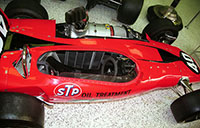 |
Why?
So much happened at Indianapolis during the sixties. For a number of Indy fans it is the most interesting decade in Indy history. Ferrari didn't play an active part in this era but as this chapter will explain there were several plans to participate.
1961: a phantom for Indy's golden anniversary
There has been persistent talk going around of Ferrari wanting to participate in the 1961 Indianapolis 500. That would certainly have been an interesting addition to all the other memorable entries and events that year, which saw the Golden Anniversary of the 500. Was it this anniversary that perhaps inspired Enzo? Did he want to be part of a special event?
According to these stories the plan came to nought since Ferrari asked for a guaranteed starting spot. With far more entries than starting spots available, as ever, the Speedway management had no reason whatsoever to grant this request. It would take another 35 years (until 1996) before the introduction of some kind of bespoke starting spots, a decision that was to have dramatic consequences for Indy, from which it is suffering to this day (2012).
As for Ferrari's supposed 1961 Indy attempt, we can only wonder about the kind of car this would have been with. Since the introduction of the roadsters in 1952 technical progress at Indy had been limited, on both the engine and the chassis side. The Offy engine still reigned supreme. The only big change to the engine since Ferrari's last participation at Indy (1956, ignoring the Monzanapolis events) had been a rule change mandating a reduction in size from 4.5 to 4.2 litre for normally aspirated engines and from 3.0 to 2.8 litres for blown engines. This had brought some improvements for the Offy. Initially, the Meyer & Drake company came with a version retaining the long stroke since only the bore was reduced, sacrificing some power. Chief mechanic AJ Watson, however, came with the bright idea to reduce both bore and stroke, using parts of both the 270CI Champ Car engine and the 220 CI sprint car engine. Key element in this cocktail was the use of shorter connection rods. The resulting engine had a slightly reduced torque output on the flywheel compared with the original 4.5 litre and the factory 4.2 litre. Power-wise, Watson's 270/220 hybrid sat in between the two factory engines (the old 4.5 and new 4.2 litre) but on track it was faster than the factory 4.2 litre. What Watson did using stock components was no problem to the factory. For readers unfamiliar with the Indy scene at that time this might be difficult to comprehend but this development was a major step in the progress on the Offy engine.
So engine-wise: Ferrari could have been tempted to stick with what they had and improve on that, be it based on the previously used straight-six or the V12 used in the 1958 'Monzanapolis'. The original 412MI engine used at Monza in 1958 was no longer accessible but new ones could likely have been built. Still, there was the problem that in recent years Ferrari's main development focus for their sportscar engines had been on the 3-litre V12 Testa Rossa engines. Actual factory-supported development on larger racing engines, be it V12s or other configurations, had been little to none, so that was even less than what had been done to the Offy during the same period of time...
On the Indy chassis side the only innovation of note since the introduction of the roadster in 1952 was the arrival of the 'lay-downs'. These were cars inspired by the 1952 Cummins TurboDiesel. Lay-downs had their Offy engines laying on their sides within the frame in order to reduce the center of gravity and reduce frontal area. The jury was still out whether the lay-downs or sidewinders were really an improvement over the classic 'upright' roadster. The first lay-down debuted in 1957, driver Sam Hanks being victorious after an impressively strong performance in the race. One year later the very same car was driven by Jimmy Bryan who also won the race! However, it can be argued that this race was heavily affected by a huge first-lap crash in the third turn that eliminated a number of the best Watson roadsters and some other competitive cars on the spot, with others losing so much time that they were effectively out of the race. It's certain that Bryan would have been a contender anyway but it certainly helped that so many of his opponents were left by the wayside. Also, the 1959 and 1960 races had been primarily contested between Offy-engined Watsons.
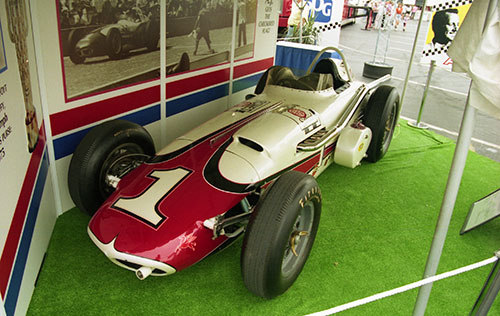
AJ Foyt won the 1961 race in this car which on first sight appears to be a Watson-Offy. Yet it wasn't. Though inspired on the drawings of AJ Watson and looking like a genuine Watson, the car was built by Floyd Trevis. This is the car as it was exposed on the 1991 Indy Fanfest, held on Carb Day that year. (photo HG)
As for Ferrari's intended participation at Indy in 1961, a roadster-style chassis had to be either built or bought in case the 1958-built Monza Special was no option for whatever reason. A point worth mentioning might be the fact that a few Kurtis-Kraft 500D chassis made the 1961 race even though they stood little chance against the later Kurtis-Kraft types, the Watsons and the best of the sidewinders.
So it remains very difficult to determine what kind of car Ferrari would have brought to the Speedway that year. All the more so since in late 1960, early 1961 the team had its hands full with the Formula 1 programme, not to mention the sportscar programme with the prestigious Le Mans 24 Hours. In 1960, even Ferrari was forced to accept that mid-engined cars had taken over F1, and Enzo grudgingly had to follow that trend. Work was carried out in 1960 already, in conjunction with work on the new engines. It paid off handsomely since the legendary 'Sharknose' Ferrari 156 was a massive success, winning the 1961 constructors title as well as the drivers title for Phil Hill. One must wonder how much distraction an Indy project would have caused.
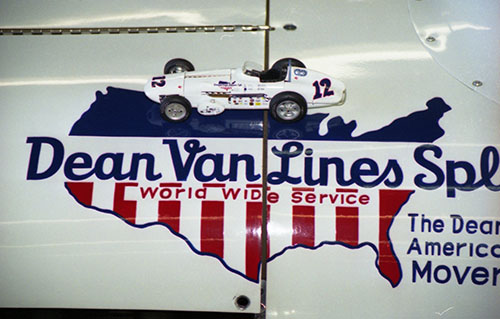
A practical joke: in 2003, at an undisclosed place, I happened to stumble onto the second-placed car of the 1961 race, with a collection of Carousel1 scale model cars a mere 10 yards away. How often do you get the chance to make a picture like this: die-cast model posing on the original. Eddie Sachs's car was a Wayne Ewing-built roadster along the plans of AJ Watson. His cars were rated as the best of the roadsters at that time. (photo HG)
One last thought about what Ferrari could have built for 1961. Ignoring 1958 412MI chassis that had been used at Monza that year and was possibly still available, Ferrari had no hardware to fall back upon. They pretty much had to start from scratch. Given the fact that chassis-wise they had made the transition from front engine to rear engine with the F1 cars for 1961, there may have been thoughts at Maranello of making their open-wheeled Indy contender rear-engined as well. Personally I feel the thought never crossed anyone's mind at Ferrari. The fact that the 3-litre capacity sportscars (so smaller than Indy's 4.2-litre limit)remained front-engined makes me believe that Ferrari stuck to front-engined designs for any car with engine larger than 3 litres, which could benefit from improved high-speed stability due to being nose-heavy. And if any track apart from Le Mans, Monza and Rheims was known for high speeds it was Indy.
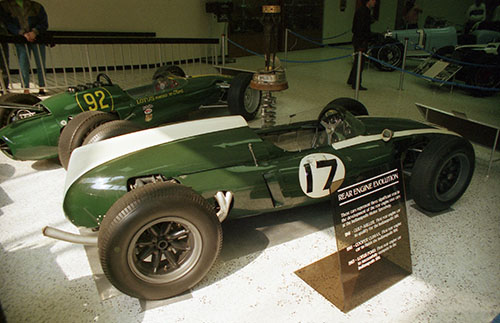
The IMS exposed a Cooper-Climax on occasion (this picture was taken in 1989) but this is not the actual car driven by Jack Brabham that year. This is said to be the backup car. It was a much less modified F1 chassis that had some Indy mods but not as much as the primary car. So perhaps not the real one but otherwise very close to the car that became a milestone in Indy history. Its 9th place in the race may not have caused upsets but with better tyres and less time lost during the pitstops the final result could have been better. (photo HG)
In the years that followed Indy also went through the rear-engined revolution even though it took some time before the revolution was completed. The last front-engined victory came in 1964. In fact, even as late as 1966 a few people were still convinced that front-engined cars stood a decent chance at Indianapolis. The most prominent man with this opinion was driver Jim Hurtubise who built two new front-engined cars for the 1967 Indy 500. One was sold off, his own car was initially supposed to have a Novi V8 engine. Andy Granatelli, the most prominent of the three Novi engine owners, had told the press about this Hurtubise project. He was said to have done all kinds of computer research on what would be the best option for an Indycar. The computer said that it didn't have to be rear-engined... Hurtubise never got his Novi engine, however, and fitted his car with a turbocharged Offenhauser instead. He failed to qualify in 1967 but surprisingly enough Jim qualified his Mallard-Offy for the 1968 race. That would be the last time a front-engined car made it into the race.
Andy Granatelli and his brothers meanwhile were doing entirely different things. Now it might read as if the final part of this chapter about Ferrari's possible 1961 exploits end in a manner that has nothing to do with Ferrari at all. But read on, and it will all make sense.
1968: Enzo and Indy's enfants terribles go 'side-by-side'
The next time Indy appeared on Enzo Ferrari's agenda was in 1968. The 1967 Indy 500 had almost been won by the controversial STP-sponsored Paxton-Pratt & Whitney turbine car. Besides its power plant the car was remarkable due to its construction of a backbone chassis with the cockpit on the right side of the frame and the engine on the left side. This lay-out was a result of the inability to fit the driver and turbine behind each other in a chassis without it becoming an excessively long car. The left side of the car getting much heavier as a result was, if anything, beneficial, specially at Indy. Apart from this construction the car (nicknamed 'Silent Sam') also differed from its opponents because of having 4WD.

By far the most disliked car to ever appear at the Speedway but certainly also one of the most innovative at Indy and in the entire history of motor racing. It drew crowds like few cars ever did. As long as IMS Museum was permitted to exhibit the car it was one of only two that didnt't win the race that were on near-permanent display. (photo HG)
Almost immediately after the 1967 race USAC announced all kinds of rule changes to restrict the use of turbine-powered (and 4WD) cars. Enzo Ferrari subsequently held talks with the owners of the turbine car, the Granatelli brothers, to supply V12 engines for their side-by-side 4WD chassis. This is the version of the story as told in Andy Granatelli's book They Call Me Mr 500. According to Andy, Ferrari had secured support from tyre company Firestone as well. He and his brothers went to Italy to negotiate and were shown a suitable V12.
Gerard Crombac also mentioned the project in his book Turbine Grand Prix but his words leave the impression that the Granatellis contacted Ferrari about the availability of its engines. Eventually nothing came of these plans. The first reason Crombac gave was that Enzo Ferrari wanted to be paid. So how eager was Enzo to participate at Indy? If he wanted lots of money it appears as if the initial contacts were made by the Granatellis, searching for an alternative for their controversial engine if they indeed should need one.
In their books, both Granatelli and Crombac give another reason why the project eventually resulted into nothing. In order to explain how this came along we must first look back on what had happened in 1967.
As mentioned, the turbine car of the Granatellis had almost won the “500” in 1967, and there is no shadow of a doubt that it was by far the car of the year. The 1967 Indy 500 is not a story of how AJ Foyt won the race but how Parnelli and the Turbine lost it. The car had made the Granatelli brothers, and Andy in particular, very much the enfants terribles at Indy. Turbine engines had always been allowed at Indy since the early fifties but rarely had they been tried seriously. The Granatellis, however, had gained valuable experience with 4WD thanks to the two 4WD chassis they had ordered (the 1964 Ferguson P104) and built (the 1965 Paxton), both propelled by the stupendously powerful supercharged Novi V8.
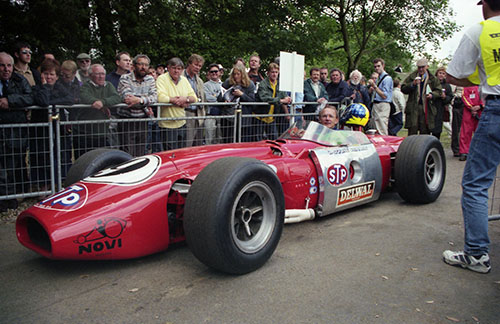
Seen at the 1998 Goodwood Festival of Speed: the behemoth Ferguson P104 4WD chassis built in 1964 for the Novi V8 engine. The usual Novi misfortune limited the experience the Granatelli brothers gained with a 4WD car in race conditions. The car is restored with the 1965 bodywork. This 1998 appearance at Goodwood was the car's first return to English soil after it was completed and sent off to the USA late March 1964. (photo HG)
The Granatellis realised that 4WD was the key component needed to get the most from a turbine-powered car. Sponsorship money was no problem so they hired and bought everything needed to create a winner, to come heartbreakingly close. Few fans liked the car, however, most hated it and every car owner but the Granatellis hated it even more. Curiously, despite the common hatred for the car among the crowd, lots of people came to the track to practice and Pole Day because they all wanted to see (and hear) the car with their own eyes and ears. Parnelli Jones was still a mighty popular driver with the majority of the crowd but the Granatellis as persons hadn't been that well liked, despite the fact they had 'given' the crowd the Novis to cheer for. With the Novi cars gone from the team, one must really wonder how much more unpopular the team would have been if they had hired a driver other than Parnelli!

There are hardly any angles to think of to make this car look beautiful one way or the other. But it worked much better than it looked. Was the bulge on the left side large enough to accommodate a V12 with a clutch? (photo HG)
Right after the 1967 race USAC came up with all kinds of plans and announcements regarding rule adjustments to disencourage the use of turbine-powered cars. They didn't ban them with a single rule but a large collection of smaller rule changes were clearly aimed against turbines. A bright person at USAC then realized the chassis itself had been beneficial as well, the 4WD in particular. All of a sudden USAC came with announcements clearly aimed against a single car. Turbines were limited, a side-by-side chassis like the STP turbine was on the brink of being outlawed, 4WD was to be forbidden or at least very much restricted. USAC indicated that it wasn't personal against the Granatellis but they had to think about the interests of the other team owners who had less money to spend. Eventually it began to look as if USAC was indeed on a crusade against the Granatellis. When news broke about a possible joint venture between the Granatellis and Ferrari, USAC immediately had the word out that they were thinking of restricting piston engines as well! One of these restrictions was to limit the prowess of multi-cylinder engines of over eight cylinders, or even introduce a maximum number of cylinders of eight. In other words: the worst-case scenario was a ban on V12s.
Curiously enough, when in 1966 Lotus considered using a 4.2-litre version of BRM's 'trickbox' H16 engine (also sponsored by the Granatellis) there were no objections by USAC, let alone threats of restrictions on multi-cylinder engines. The ban now considered being imposed on multi-cylinder engines was rather suspicious given its timing and recent developments.
It became one reason why plans between Granatelli and Ferrari never bore fruit. Another was that the restrictions on turbines, 4WD and side-by-side chassis didn't all materialize. First, a reduced turbine capacity was introduced, side-by-side technology remained allowed, while 4WD was also allowed to continue with the fat rear tyres forbidden from now on: only the smaller-sized front wheels were permitted on both axles. The Granatellis took up the challenge, dragged Colin Chapman and Lotus into the project and together wrote another massive piece of motor racing history. A revised version of the 1967 side-by-side chassis powered by the smaller turbine also became part of the 1968 Granatelli team.
Maybe it was because of the clear intentions shown by the Granatellis that they no longer had plans to use Ferrari V12 engines in whatever car that a ban on engines of over eight cylinders wasn't enforced after all. Nevertheless, the suggestion by USAC to come up with such a ban was perhaps the best proof that Ferrari had been dealing with, indeed, the enfants terribles of Indy at the time.
So for 1968 Ferrari wasn't an option, let alone a partner for the Granatelli brothers. Another reason why Ferrari didn't become involved in the Granatelli plans was very straightforward: Enzo Ferrari insisted 'his' V12 only be used in a side-by-side chassis and never in any new Lotus car the Granatellis were funding!
Nevertheless, this Ferrari-powered side-by-side 'might have been' project is interesting to dwell upon a little longer when it comes to the following question: what kind of hardware could Ferrari have provided? So let's take a look at the situation at Ferrari at the time.
Ferrari had again taken up the use of over-3-litre four-cam V12s since an experimental Le Mans category had been created in 1962. Ferrari's last front-engined Le Mans winner had been inspired by the recent Testa Rossas but fitted with a 4-litre engine. The new, mid-engined V12 cars introduced in what with hindsight became known as the P-series endurance racers started with 3-litre engines at first but eventually larger engines up to 4-litre capacity appeared. These found their roots in the fourcammers of the late fifties. Then in 1966, the Formula 1 rules permitted the use of 3-litre engines and Ferrari was among the few constructors to have a full 3-litre engine race-ready: their V12s of course. The use of these engines went on into 1967.
In 1967 the situation was that Ferrari had quite an array of engines and even more technology options available to them. So what kind of engine could Ferrari have provided for a side-by-side Indycar? Would it have been inspired by the latest Formula 1 engines or would the long-distance sportscars engines as used in the 412P (P3 spin-offs) and P4 be the main source of inspiration? Possibilities abounded, and we haven't yet mentioned the options on cylinder head design: two or four cams, two valves or three, single or dual spark plug, location of inlet and outlet manifolds.
Ferrari's primary battle wagons for long-distance racing in 1967 were the gorgeous 330P4s, powered by a four-cam V12 with three valves per cylinder (two inlet, one outlet), dual ignition and Lucas fuel injection. Its bore and stroke were 77x71mm which gave a capacity of 3967cc. In the P4 this engine was rated at 450hp at 8000rpm. On first sight this engine appears to be the best candidate as a starting point for a new Indy engine.
If the engine of choice was an atmo engine then the P4 engine uprated with some F1 experience appears to be the first choice. Adding an extra 200cc to get to the maximum permitted 4.2 litre was feasible. In 1965 Ferrari had debuted the 365P endurance car for customers, and this car was powered by a 4.4-litre version of the V12. Compared with the 1967 P4 engine the extra 0.4 litre capacity came from an increase of the bore with 4mm (81mm instead of 77mm) with a 71mm stroke being retained. This larger 365P engine, however, had to do with two cams and two valves per cylinder.
It's clear that a 4.2-litre cylinder block underneath P4-spec cylinder heads had to be feasible. With some more tuning and optimising something in the region of 500hp might have been obtained, and perhaps even more if four-valve heads could have been developed for it. Such heads were debuted in the 3-litre V12 F1 engine at Monza in 1967. Could these heads have also been an inspiration for the larger engines? However, what appeared to be the most suitable solution wasn't chosen in the end.
Andy Granatelli stated in his biography that while visiting Maranello he had seen an 'all new' V12. I had the privilege to have an extended interview with Andy Granatelli in 1989 for an entirely different project but the plans for a Ferrari-engined side-by-side car came up for discussion very briefly. On my question to dig more into detail on this engine Andy revealed that it was a twin-turbocharged V12. Correspondence with Ferrari experts, however, didn't confirm the existence of a turbocharged V12 in that period of time but corresponding directly with Ferrari yielded an answer by Franco Gozzi who stated that during the talks between Ferrari representatives and the Granatellis a 2800cc version derived from the 3000cc F1 engine was discussed.
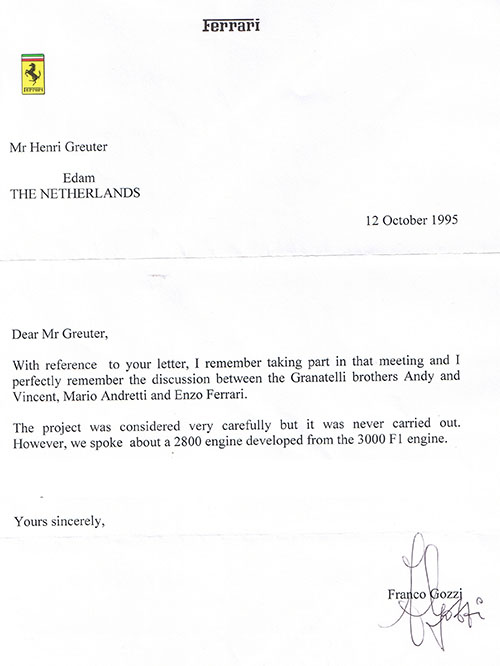
Probably the best piece of evidence that Ferrari was indeed working on being present at Indy in 1968 is this letter by Franco Gozzi. Even though the letter doesn't specify it, the engine was most likely to be turbocharged, given the 2800 cc capacity mentioned by Gozzi. (photo HG)
Andy Granatelli doesn't have the best of reputations for being accurate in supplying information to historians. This may put his mention of seeing a turbocharged V12 in doubt. However, I do have a different experience with Andy in which some unlikely things he told me were proven to be correct by evidence supplied by others. That's why I mention Andy's remarks and why I checked these. Maybe there was no engine yet but if it would have been built it could well have been a blown 2.8 litre, must likely turbocharged.
So what about the chances of a Ferrari-powered 'Silent Sam'? Let's begin with Ferrari's input: the engine. The easy way out would have been a 4.2-litre atmo engine. The side-by-side chassis was more than capable of housing a lengthy V12 engine. What remains an intriguing thought is what the inlet and exhaust lay-out would have had to be. The left side of the engine couldn't have been that much of a problem. The right side was a different matter. If the engine would have used inlets within the V and exhausts on the outside, an exhaust pipe would have had to be hidden deep inside the car, meaning a lot of heat had to be discarded somehow. In case of a center exhaust like that on the Ford V8 the question would have been how to get enough air into the right-side cylinder bank. An inlet on the outside of the V would have been compromising, perhaps avoidable if the inlet tracts were fitted in Ford V8 fashion. But that required the use of double overhead camshafts. However, a Ford had been squeezed into a Watson roadster chassis before so Ferrari had options and could have been inspired by this earlier installation.

A replica of the Watson-Ford V8 entered for the 1965 Indy 500. AJ Watson felt that the extra power of the Ford over an Offy would give the classic Indy roadster the edge over the rear-engined cars again. Even if that meant sacrificing the elegance of the roadster's appearance. The car failed to qualify but could it perhaps have inspired the Granatellis to finding a way how to put a V12 engine in their Paxton side-by-side chassis? (photo HG)
The Granatellis even considered putting their Novi V8 in the chassis. Talk about an animal of an engine to work with.
Maybe tilting the V12 over to the left by a couple of degrees could have been of some help. Anyway, let's assume the logistics could have been worked out, with a V12 being fitted into the chassis. The next question would be: did the resulting car have any chance against the opposition?
1968 was more or less the final year in which Ferrari might have stood a chance with their atmo V12s. The turbocharged Offenhausers were getting stronger, and that year it became clear that they were capable of taking supremacy from the normally aspirated Ford V8 engine. But the Offies could still be beaten in 1968. No matter how much power (and torque!) an atmo Ferrari V12 would have had, as long as it was close to the Ford V8's output, preferably having some more, Ferrari would have had a chance as long as the higher output didn't come at the expense of excessive fuel consumption. Increased weight due to larger fuel loads or even worse, an extra fuel stop necessary to make up for the fuel consumption, wasn't what Ferrari needed.
It appears, though, as if Ferrari opted for the most difficult option: turbocharging a 2.8 litre. Given the lack of experience with turbochargers and recent experience with blown engines apparently unexisting as well, you may wonder if a few months were enough for Ferrari to build a reliable, competitive engine. Fitting it into the side-by-side chassis should have been not that much of a problem for the actual engine block but it would have been quite a challenging task squeezing a turbocharged engine with all the required ducting and tubing related to the turbocharging into the chassis. Where would the glowing hot turbo (or turbos) be positioned? Let's not even think about anything else…
To evaluate the chances for a turbocharged V12 engine against its opponents, pretty much the same as what is listed for the 4.2 liter atmo engine was valid for the turbocharged version as well. But all of this with the handicap of to achieve it with a brand new engine of which output figures were demanded that called for hp/cc ratios which were entirely new for Ferrari. Experiences with the turbocharged Offies in 1966 and 1967 indicate that Ferrari would be on a steep learning curve on which instant success was too much to ask for.
Then there was the side-by-side chassis. 'Silent Sam', although improved and lightened for 1968, was still outclassed by the similarly powered Lotus 56 'wedges'. (All the STP team cars used specially adapted Pratt & Whitney ST6 gas turbines.) Only when using rather extreme settings the 56s were superior in speed over their opponents but this setup could only be used over a short period of time and was unsuitable for the race. In race day trim, the turbines were short on power compared to the piston engine-powered brigade. Thanks to their fantastic handling, corner speeds and acceleration (courtesy of 4WD dealing superbly with the massive turbine torque) they could impress to some extent but only Joe Leonard was able to run with the leaders. He was close to winning but retired after a restart after 191 laps when the fuel pump driveshaft broke down as a safety measure.
So 'Silent Sam' was uncompetitive in conditions in which the Lotus was competitive despite being underpowered. Would a Ferrari powered 'Silent Sam' (with either atmo or turbocharged engine) have been more competitive and capable of fighting for victory like the car had done the year before when it had about as much power as its rivals? Difficult to say since factors like overall car weights and its fuel consumption are difficult to estimate. No doubt that whatever V12 was used it would have been much heavier than the turbine it replaced. The chassis had 4WD which was required to make the most of the tremendous torque the turbine provided. No way that the V12 could match that figure so to shed some weight it would have had to be converted to rear-wheel drive. However, the fine handling of the year before had been a result of 4WD so 'stick with what you had' would have made sense. Also, the Granatelli Brothers had become staunch supporters of 4WD.
So much to consider, so many unknowns. It is simply impossible to make up a solid and well-founded argument for the competitiveness of a Granatelli-entered Paxton-Ferrari V12 'side-by-side' car.
And after the following revealings there is another question to ponder. As mentioned, the Granatellis eventually had four turbine-powered Lotus cars built. But in literature a wide array of alternative power plans can be found for the eventual STP Specials. For the Lotus 56s there was talk of using Chapman's connections with Cosworth to have a 2.8 litre turbocharged version of this engine. Another project is even more curious given the considered ban on multi-cylinder engines that eventually was a factor in the cancellation of the Ferrari V12-powered car. No way that this proposed engine could have been banned because of having too much cylinders since it didn't have even a single one! The plan called for ordering four four-chamber rotary engines with a 240 CI (3.93 litre) capacity with Curtiss-Wright. The power output of such an engine was estimated at 800 or so hp when using alcohol fuel. According to a spokesman in the article that is our source, this plan fell foul of people at Curtiss-Wright not taking it seriously enough.
The curious thing about this project is that the article suggests it was meant for the 1969 race at Indy. Surprise, surprise, the 1967 rule book had allowed rotary engines, however, they weren't being listed as eligible in 1968! (By the way, in the light of other proposed rule changes and the reasons behind them: what a coincidence.) And would the Granatellis really have spent time on a plan for 1969 if the type of engine in question wasn't eligible in 1968 already? Could it instead have been yet another alternative that the Granatellis had given attention to with the 1968 race in mind before the rule change was announced? If that was indeed the plan, it would have ended in tears anyway. As mentioned already, there was talk about fitting the 'side-by-side' chassis with a Novi V8 engine. At least that engine was ready and available but it had its own handicaps that in over 20 years had never been solved sufficiently. The interesting part is that a rumoured 1967 modification to the Novi V8 wasn't put to the test since no Novi-powered car was entered. But reality forces us to accept the thought that between 1961 and 1966 the Granatellis had failed to succeed with the Novi and the chance that everything would come good all of a sudden after a sabbatical year is very unrealistic.
Now, considering all these alternatives, the question may arise: how willing were the Granatellis to bring a Ferrari-powered car to the Speedway? I have the feeling that it really depended on the commitment by Ferrari to provide the hardware and preferably with as little money from the Granatellis' own or STP's pockets needed for getting the actual car up and running. If it hadn't been the Granatellis needing Ferrari but the other way around, with Ferrari making serious work of it, including taking care of the project's funding, be it by themselves or with sponsors that were acceptable to the Granatellis, the improved Paxton chassis may not have been turbine-powered after all and wrecked in a practice crash in May 1968.
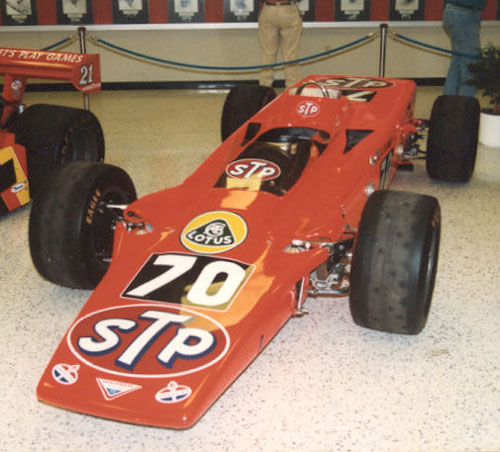
This was built instead of a Paxton-Ferrari 'side-by-side'. It was at least as revolutionary in motor racing history and Indy history as the car that inspired it. Apart from its 4WD and the engine making it a memorable machine, the Lotus 56 was one of the very first cars ever built using its bodywork in order to generate downforce and enhance grip. And boy, did it work! (photo HG)
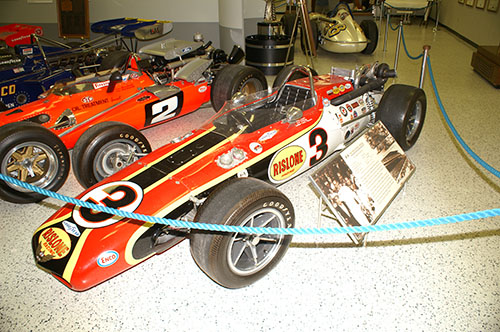
The winning car was much less innovative than the Lotus 56: Bobby Unser's Eagle. Still the car made it into the history books since it was the first time at Indy that a car with turbocharged engine won the race. If it came to cars using blown engines in general it was the first winner since Robson's 1946 Thorne entry. (photo HG)
